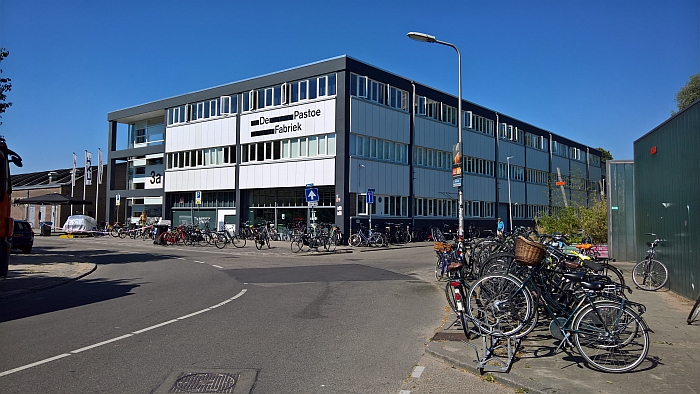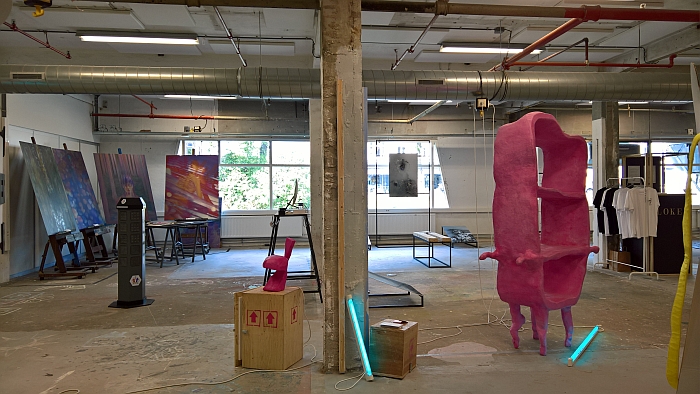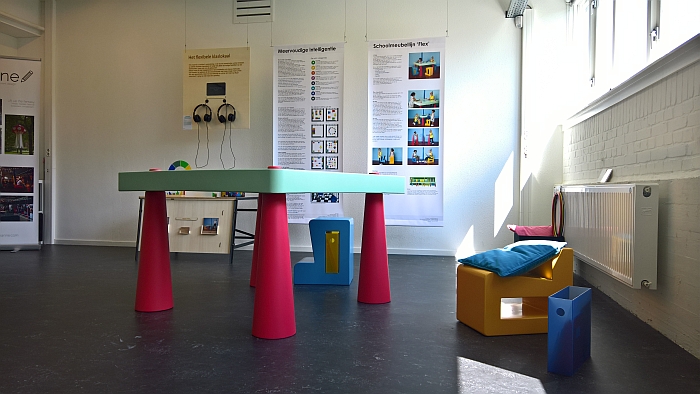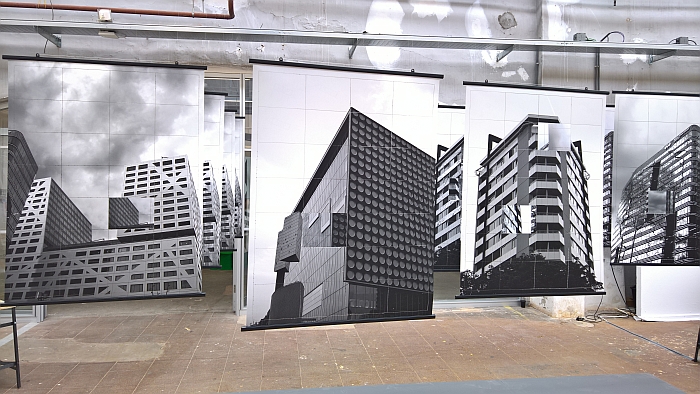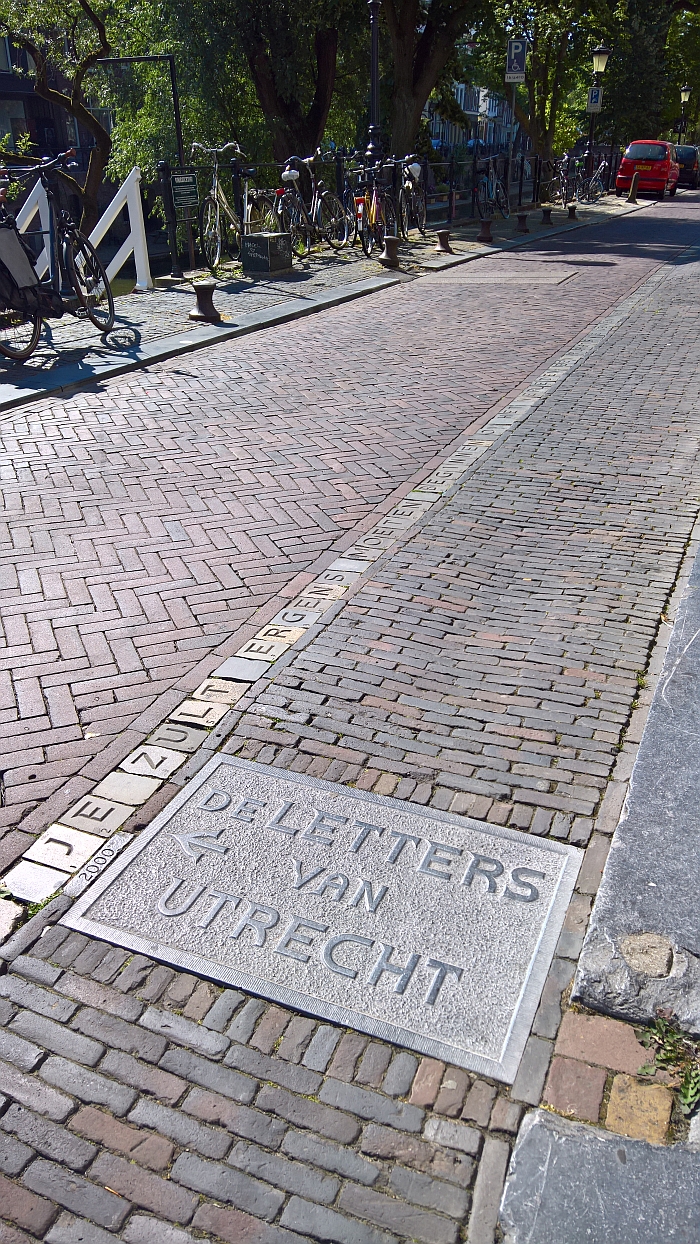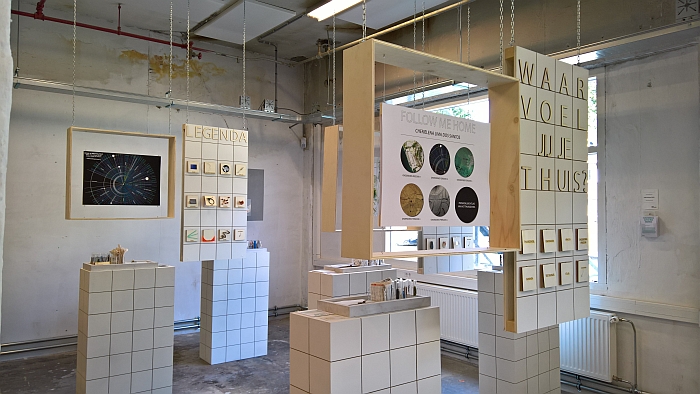#campustour 2018: Exposure, Hogeschool voor de Kunsten Utrecht, Netherlands
Since 2000 Utrecht has been home to, when not the world’s longest poem, then certainly the world’s longest-term poem: running its way down Oudegracht through the heart of the inner-island, De Letters van Utrecht is extended every Saturday by the addition of a new letter, a process planned to continue ad infinitum. And which is in many ways similar to how smow blog posts are formed: we start writing, adding new words at regular intervals, without any real plan, far less any intention, ever to stop, but rather to just keep going on and on and on and on and on and on…….
As we strolled down Oudegracht towards the Hogeschool voor de Kunsten Utrecht’s Exposure 2018 Graduation Exhibition the last letter set was number 965, was to be the first letter of a new word, and was a Z. But what would the new word be? Zaaien? Zaakkennis? Zakken, zalig, zalf, zagen, zangliefhebber, zakdoekjesboom, zandloperdolfijn?
Putting down our dictionaries we headed for the Hogeschool voor de Kunsten Utrecht…….
Hogeschool voor de Kunsten Utrecht, Exposure 2018
Formally established in 1986 through the amalgamation of four creative colleges in Utrecht and two in Amersfoort, including Amersfoort’s Carillon School, the contemporary Hogeschool voor de Kunsten Utrecht, HKU, is home to some 3,900 students studying undergraduate, postgraduate and doctoral programmes in the college’s eight schools: Art and Economics, Fine Art, Games and Interaction, Media, Music and Technology, Theatre, Utrechts Conservatorium & Design, the latter offering Bachelor degrees in Fashion, Spatial and Product Design.
Judging from the projects presented in context of Exposure 2018, design at the HKU is not strictly understood in context of Leer van het Ornament, the “Theory of Ornament” education principles propagated in the Netherlands at the start of the 20th century and as featured in the Gemeentemuseum, Den Haag’s exhibition Art Nouveau in Nederland; arguably no surprise in Gerrit T. Rietveld’s home city, throughout Utrecht one finds numerous delicious architectural examples of how Rietveld challenged conventional wisdom as regards form, materials, construction, function and ornamentation. However the much more conceptual nature of the majority of the works presented at Exposure 2018 indicate less the influence of a structural rationalist like Rietveld and rather the influence of more recent movements in Dutch design.
Which isn’t a complaint, far from it, and is most certainly a subject for a later, post-#campustour, post when we have a little more time to reflect on the experiences of the past weeks.
Here our focus is those works we saw which, for various reasons, got us thinking and which have been occupying our thoughts since Utrecht.
Incandescence by Pelle Schilling
Born into a family of metalworkers Pelle Schilling was raised with the bang of the hammer and flight of the spark in the metal workshop, eventually learning the trade himself. And as he did, and for all as he became more involved in the daily business, the childhood fascination for the noise, light, fire and heat of the metal workshop waned. The focus became the functional and the tangible. Arguably the profitable, Pelle didn’t say that, we’re freely extrapolating.
With Incandescence Pelle attempts to rediscover that fascination. Presenting three projects: Droplet which turns a single drop of molten metal into a fountain of light; Wire which sees a glowing thread of metal forced into a nest of metal wire with the resulting random sparks and molten drops creating a form of mobile/active light bulb; and Rain in which angle grinders and steel bars unite to create a shower of sparks. A metal umbrella being on hand for those who find themselves caught in the downpour.
Two things in particular interest(ed) us about Incandescence, the first is the wonder and fascination of childhood that gets lost as we get older. It clearly shouldn’t. It should remain forever
And the other is that it was through working professionally that Pelle lost the wonder and magic of the sparks, which is clearly analogous with the way we all, regardless of our job, can lose sight of the essentials once we become embedded in the reality of the daily routine; for Pelle that meant the wonder of the sparks and the poetry of the choreography of the metal workshop, for others in other professions it could mean a loss of focus on customers, colleagues, processes, quality, innovation.
Got to keep seeing the sparks people. And if you don’t, go search for them.
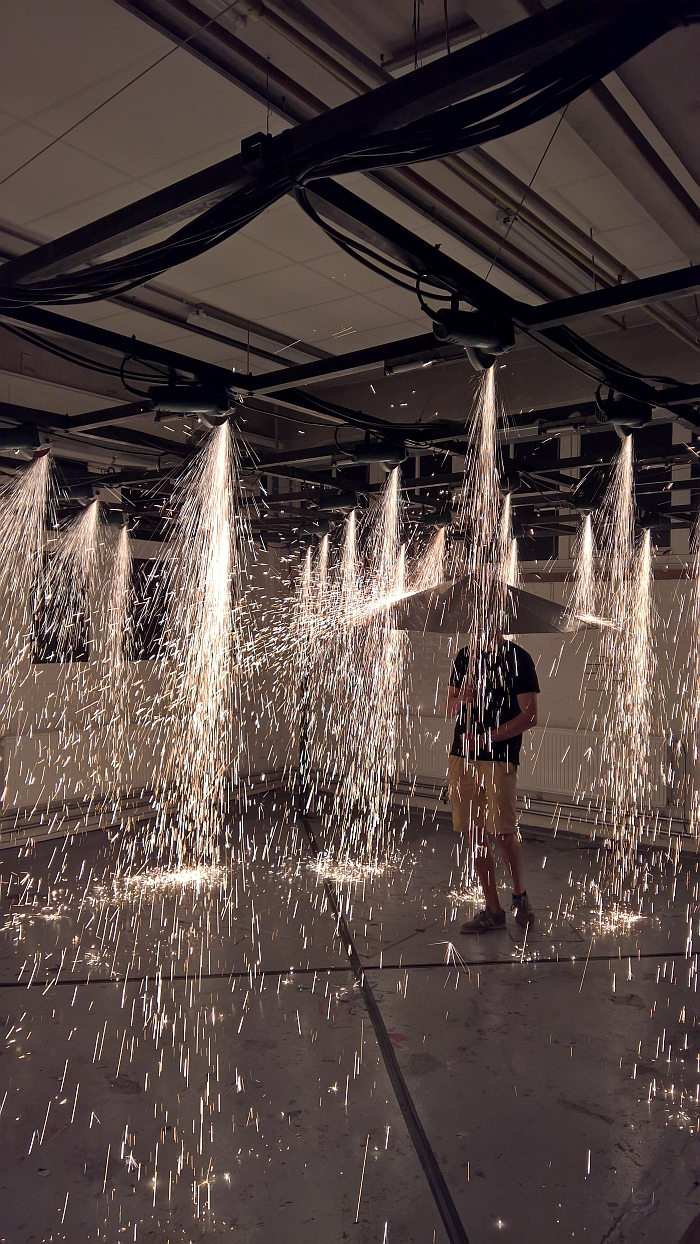
Rain part of Incandescence by Pelle Schilling, as seen at Exposure 2018, Hogeschool voor de Kunsten Utrecht
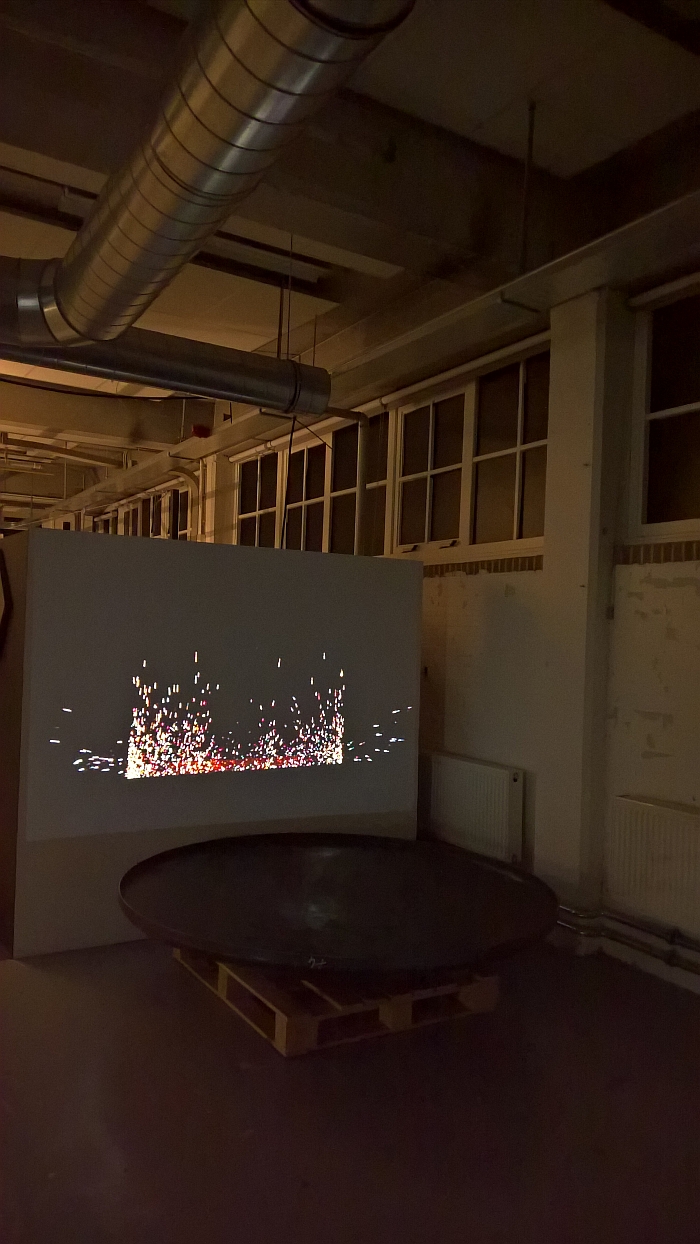
Droplet (video presentation) part of Incandescence by Pelle Schilling, as seen at Exposure 2018, Hogeschool voor de Kunsten Utrecht
Flex by Jeanine Middelman
According to Jeanine Middelman Flex began as considerations on primary school furniture, for all the different activities primary school children undertake in the course of their lessons, and the inflexibility of much contemporary school furniture, an inflexibility which, according to Jeanin, often manifests itself as an inappropriateness. The result of her considerations is a superlight weight table and stool set, both parts of which feature extended functionalities.
The table top is reversible and can be used both as desk or as surface for boardgames, while the whole table can be effortlessly taken apart and, for example, the legs used as components in sport/creative activities while the top can be re-functioned as an ad-hoc room divider
The stool can not only be used in a high or low seating position, or as a step to reach things on a higher shelf, but also contains a very nice gap into which pupils can keep boxes with their personal books, utensils, works in progress etc.
Aside from its variability Flex‘s other defining feature is its lack of mass, a consequence of the chosen material, Styrofoam (EPS), a material Jeanine assures us, on account of the production process, is sturdy, durable and applicable for a classroom environment. And we see no reason to doubt her.
Still with a little development work ahead of it Flex looks promising, and, in our opinion, the stools also have a potential away from the classroom, not least in office, commercial, social environments or wherever flexible seating solutions are required.
Ruined by Yusuf Deniz
“Many new buildings are no longer being built for eternity” writes Yusuf Deniz, “New buildings no longer get the chance to grow old. We will never experience them as ruins”
And he ain’t wrong.
Yet while architects, politicians and urban planners put up, pull down, put up and pull down buildings as it suits, what does that mean for the nature of our relationship with the cities in which we live?
In context of his spatial design graduation project Yusuf imagined new buildings in Utrecht as if they were ruined.
Presented as series of physically manipulated photos, Ruined is one of those, superficially, simple projects which produces a very direct effect and automatically forces you to consider the nature, reality, sense, purpose and direction of contemporary urban planning and construction. And what future generations are going to do with all our skyscrapers?
ÄGG by Jan van Steenbergen
ÄGG by Jan van Steenbergen is in many regards the perfect object for the digital, autonomous networked app based future so many long for.
Originating in considerations on global food production, processing, distribution and consumption, and for all the unsustainability of the contemporary global food industry, ÄGG proposes a solution.
It’s a chicken cage for your kitchen.
As Jan states, with a chicken in your kitchen you have a regular supply of eggs, manure for your veg plot and a willing recipient for your food scraps, plus, which is where ÄGG takes on its true wonder, when it is needed, ÄGG transforms into a chicken roasting oven.
Born-Reared-Roasted-In-Situ. Perfect.
In a its soul a very dark piece of work, ÄGG, through telling you that you can solve all your food problems by rearing and roasting a chicken on your kitchen work surface, very neatly highlights the absurdity of many of our contemporary technological innovations and for all their developers’ claims how they will improve our future lives. They won’t, because they focus on reenforcing existing behaviour rather than seeking alternatives and in doing so not only fail to tackle underlying problems but, invariable, create new problems. But unlike the thought of a chicken living in its own roaster on your kitchen work surface, we can’t see the absurdity of the claims. Even if we do accept there will be people who consider ÄGG the best domestic appliance developed since the toaster.
Full details on the Hogeschool voor de Kunsten Utrecht can be found at www.hku.nl
And all 2018 Hogeschool voor de Kunsten Utrecht Graduation projects can be viewed at https://exposure.hku.nl/portfolio/design
Tagged with: #campustour, Hogeschool voor de Kunsten Utrecht, Utrecht
